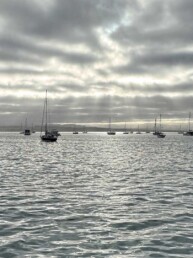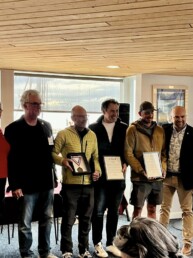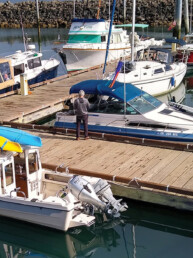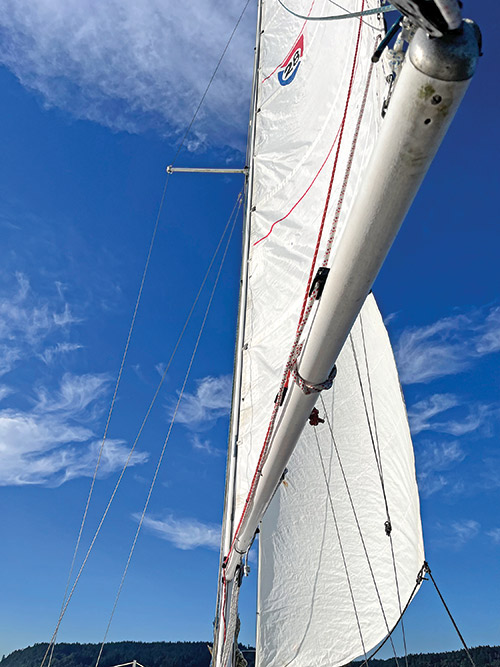
Helpful Lessons on Headsail Trimming for Novice Sailors
While I have yet to participate in a sailboat race, I have to admit that the idea is intriguing. However, as a new sailor and old owner of a sluggish sloop, I think that evening flotillas and weekend rallies are best suited for my current level of sailing ability. Even a slow afternoon cruise near our marina offers me an opportunity to learn something about sail trim and course headings.
At a recent club-sponsored sail rally, my wife, Laura and I found ourselves aboard Ariel, our 28-foot Columbia sailboat, as one of only two boats from our dock participating in the evening event. It was the kick-off date of the bi-weekly summer series, “Get Out and Sail”, with beautiful weather accompanying our first late afternoon sail of the season.
Though we were somewhat disappointed with the low turnout of fellow boaters, we realized that it really only takes two boats on the water for a race. The evening turned out to be a great opportunity to share our burgeoning love of sailing with an with an experienced and supportive club member who gave us a lesson on sail trim.
We left the marina about 5:30, just behind Xocomil (pronounced “Zoco-mill), a C&C 37/40, with skipper Rob Nettleton at the helm. After smoothly raising our jib and main, we were fortunate to maintain the same course within earshot of the swift yacht for the better part of an hour, mostly because of Xocomil’s self-imposed handicap. Rob was solo-sailing with just the jib in the 6-8 knot winds. Although from the size of the gray carbon-hybrid sail, he had about as much canvas catching the cool evening breezes as Ariel’s jib and main combined.
Our old but dependable boat, along with my inexperience, were no match for Xocomil’s speed and genoa, but it didn’t stop us from enjoying the unofficial race to a shoreline buoy in the southern end of Commencement Bay. Rob made a tight turn with a smooth tack around the marker, demonstrating how it’s done without having to utter a word.
But in the spirit of nautical camaraderie, after rounding the mark, Rob went on to explicitly share some of his expertise with us by shouting out suggestions for trimming Ariel’s sails as he observed Laura and I in his wake, or, after sailing circles around us, just off his port bow.
“Tighten the headsail a bit,” he advised, in a calm voice that cut across the quiet waves between our two boats. With Laura at the helm, I pulled in the sheet, closing the gap between the two sails of our 1975 vessel.
From my vantage point in the cockpit, the shape of the headsail appeared to be more planar than the billowed main. I was under the impression that the jib and main should possess “parallel” curves, when viewed from above. But Rob’s observation made me pause.
When friends with longtime sailing experience have come aboard they usually instruct me in referencing the telltales on the trailing edge of the main, along with the Windex atop the mast. Those two indicators help me set the main sheets and traveler in conjunction with the course heading.
But since our jib has no telltales, I usually adjust it with the sheets alone, setting its curvature and location by eye, which has suited me well enough in the brief time that Laura and I have been sailing.
I’ve since done some research on trimming the sails. While not as effective as direct experience on board Ariel or any other sloop for that matter, reading about sail placement has given me some working knowledge to apply when making adjustments.
As with so many nautical aspects, the more I read about head sail trim, the more I realize how little that I know. But using some of my knowledge from teaching high school geometry for over 30 years, I was able to at least understand some of the basic components as I continued studying.
Since the “center” rotation point of the jib and main, when viewed from above (the forestay and mast, respectively) are a good distance apart where they meet the deck, my initial concept of concentric curves is not really applicable, especially since both sails flatten out toward the aft end of the sail.
Skipper Rob was able to observe three ”curves” of the jib: the trailing edge, or leech; the foot from the tack to clew; and the draft, or “pillow-shape” of the sail.
My inexperience directed all of my attention to the adjusting trim with the sheet, which affects draft and shape in a macro sense. How and why to adjust the other two characteristics of sail shape hadn’t really occurred to me.
I now understand that moving the jib block slider car aft produces a more linear foot; moving it forward pulls downward, creating a more linear leech, but a bigger pillow shape, or draft.
And, continuing with my research and lessons from other sailors, I began to understand the role of the main sail location, and its potential effect on increasing the driving, or lifting force of the jib. It makes me wonder how much faster Xocomil could have cut through the water had Rob chosen to hoist it.
The main can “squeeze” the airflow on the windward side of the jib and, when properly adjusted, create what I learned is called the Kutta condition, named after Martin Kutta, a German mathematician. The ideal condition occurs when the airflow or wind leave the trailing edge of an airfoil or sail smoothly, essentially following the same curvature path as the trailing edge.
But despite my newfound awareness of nautical airflows, it’s still early in my partnership with Laura and Ariel to spend too much time fussing with sail trim, jib blocks, and leech lines. In the meantime, until I install telltales on the jib, Ariel’s heading and sail trim will be my focus, along with avoiding debris and other ships during our journey.
On our return leg to the marina, a massive tanker was in the path of the shortest route to the “finish.” We could head to port and squeeze between the tanker and the shore close-hauled on starboard tack. Or we could head to starboard of the tanker on a beam reach, and upon clearing the massive ship, come about onto starboard tack to our marina.
Wanting to stay close to shore and knowing that our engine could take us home at any time (it wasn’t really a race, after all), Laura and I opted for the first option closer to shore, while Rob, who was about a quarter mile ahead of us, chose to sail the reach taking him farther north of the marina.
As the wind picked up a knot or two and the sun set behind the forested hills of Point Defiance Park, Ariel was holding fast on her course, with the jib sheets about as tight as I figured was reasonable. I sighted Xocomil once we were past the freighter, now heading to the marina on a starboard tack. By my estimate, her course appeared to put her just a bit behind that of Ariel’s, maybe due in part to the effect of the massive ship that divided our courses.
With our two boats closing in on the marina, my decision to take the route toward the shore gave me a slight advantage. It turned out that the massive tanker did create a bit of a wind shadow for Xocomil, slowing her just enough for Ariel to gain on her by the time we approached our destination.
Feeling confident and satisfied with our evening sail, Laura and I dropped the jib and flaked the main, cruising into the marina just ahead of the Xocomil, with her effective and powerful genoa now furled.
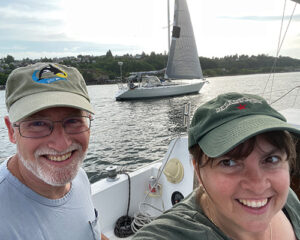
After tucking Ariel into her slip, we walked across the dock to Xocomil and expressed our gratitude to Rob for his mentoring and kindness. He had given me and Laura the boost we needed to feel like maybe we might be sailors after all. And who knows, after a few more informal regattas like this one, maybe I’ll even sail across a real finish line someday, with telltales streaming on the jib, and a well-set draft on the main.
David Casey is a retired math teacher and semi-professional woodworker and bass player. He plans on using his retirement to build a small sailboat and a kayak, and to explore the waters of southern Puget Sound.

